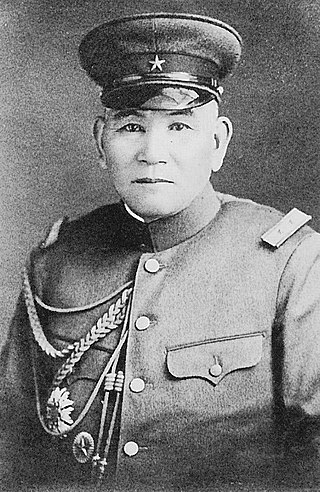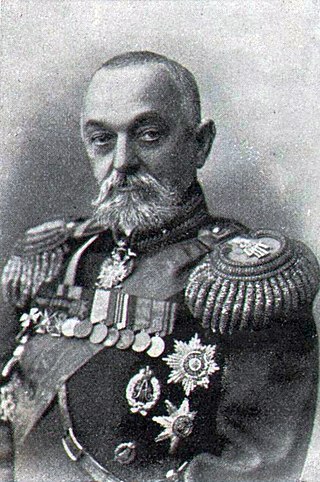
Senjūrō Hayashi was a Japanese politician and general. He served as Imperial Japanese Army Commander of the Japanese Korean Army during the Mukden Incident and the invasion of Manchuria. He briefly served as prime minister of Japan in 1937.

The Finnish Army is the land forces branch of the Finnish Defence Forces. The Finnish Army is divided into six branches: the infantry, field artillery, anti-aircraft artillery, engineers, signals, and materiel troops. The commander of the Finnish Army since 1 January 2022 is Lieutenant General Pasi Välimäki.
The Imperial Guard of Japan has been two separate organizations dedicated to protection of the Emperor of Japan and the Imperial Family, palaces and other imperial properties. The first was the Imperial guard divisions, a quasi-independent elite branch of the Imperial Japanese Army, which was dissolved shortly after World War II. The current organization is the Imperial Guard Headquarters, a civilian law enforcement organization that is part of the National Police Agency.

Field Marshal The Marquis Nozu Michitsura was a Japanese field marshal and leading figure in the early Imperial Japanese Army.

Jinzaburō Masaki was a general in the Imperial Japanese Army in World War II. He was regarded as a leader of the Imperial Way Faction within the Japanese military.

Ichinohe Hyōe was a Japanese soldier, military strategist, Imperial Japanese Army officer, and Shintō priest.

Motoo Furushō was a lieutenant general of the Imperial Japanese Army and commander of the Japanese Twenty-First Army in 1938 during the Canton Operation.

Bunzaburō Kawagishi was a lieutenant-general in the Imperial Japanese Army during the early stages of the Second Sino-Japanese War

The 11th Division was an infantry division in the Imperial Japanese Army. Its tsūshōgō code name was the Brocade Division, and its military symbol was 11D. The 11th Division was one of six infantry divisions newly raised by the Imperial Japanese Army after the First Sino-Japanese War (1894–1895). The division received its colors on 1 October 1898 and was disbanded in September 1945. Its troops were recruited primarily from communities in the four prefectures of the island of Shikoku. It was originally headquartered in the city of Zentsuji, Kagawa, and its first commander was Lieutenant General Nogi Maresuke.

Umezawa Michiharu was a Bakumatsu period Japanese samurai who went on to become a general in the Meiji period Imperial Japanese Army.

The Imperial Russian Army or Russian Imperial Army was the armed land force of the Russian Empire, active from 1721 until the Russian Revolution of 1917. It was organized into a standing army and a state militia. The standing army consisted of regular troops and two forces that served on separate regulations: the Cossack troops and the Muslim troops.

Mikhail Ivanovich Zasulich was a general in the Imperial Russian Army, noted for his role as commander of the Russian 2nd Siberian Army Corps in the Battle of the Yalu River, of the Russo-Japanese War of 1904–1905.

Nikolay Aleksandrovich Kashtalinsky was a general in the Imperial Russian Army during the late 19th and early 20th centuries. He fought in the Russo-Turkish War (1877-1878), Russo-Japanese War of 1904–1905, and in World War I.

Alexander Wilhelm Andreas Freiherr von Kaulbars was a Baltic German military leader who served in the Imperial Russian Army during the late 19th and early 20th centuries. A noted explorer of Central Asia, he was also regarded as one of the original organisers of the Russian Air Force.

Mikhail Ivanovich Batyanov was a general in the Imperial Russian Army.

Baron Tsuchiya Mitsuharu was a general in the early Imperial Japanese Army.
The 1st Siberian Army Corps was an elite unit of the Imperial Russian Army. It was raised in May 1900 and disbanded in August 1918.
The 1st Siberian Rifle Division was an infantry formation of the Russian Imperial Army that existed in various formations from the early 19th century until the end of World War I and the Russian Revolution. The division was based in Ussuriysk in the years leading up to 1914. It fought in World War I and was demobilized in 1918.
The 3rd Siberian Rifle Division was an infantry formation of the Russian Imperial Army that fought in World War I. During the Russo-Japanese War, it was officially called the 3rd East Siberian Rifle Division.
The 5th Siberian Rifle Division was an infantry unit of the Imperial Russian Army. The division was formed in 1904 from a brigade, fighting in the Russo-Japanese War and World War I.














